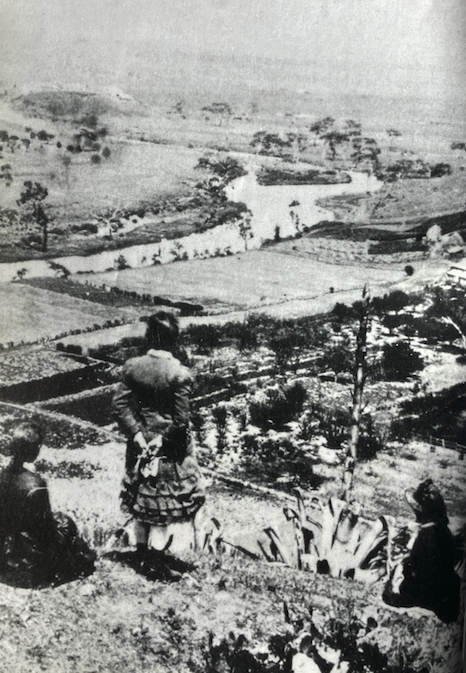
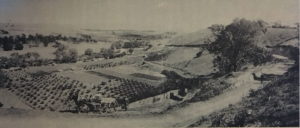
The Deviation shortly after its completion in the 1930s.
Never cease to be impressed by the fact you can drive three sets of lights out of Geelong along Aberdeen St and you’re in the bush.
Over Pako, Shannon, Minerva, about three klicks, and you’re looking down at the Barwon-Moorabool confluence and Queens Park. A bit further, over a few swales and saddles, you have Ceres, and further out again the rolling Barrabool hills.
It’s a killer view, one that’s been celebrated for yonks via cameras, binoculars, phones and natural orbs from the brutalist concrete lookout on Patten Court – likewise, innumerable windshields and occasionally painter’s easels.
The top of the Deviation, as Deviation Road on the Hamilton Highway is best known, is a picture perfect Instagram sunset fixture, a magical misty tour de force in winter and a wellspring of nostalgia for many Pivotonians.

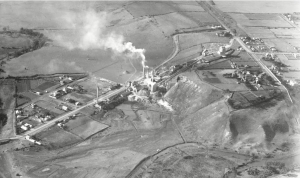
Left: View from the top of the Deviation. Right: Photograph by Charles Pratt before the Deviation’s construction.
The arc bearing north then west above its tumbling roadway, and occasionally its tumbling cliff-face, is a realtor’s reverie with its knockout outlooks over the caldera-like park below and the serpentine path of the river winding through its steep Newtown riparian borders. Pretty much have to wait for someone to die to buy in there.
That roadway dates to 1933, built as a Depression project for unemployed labourers and about half a century after Fyansford residents started calling for an alternative to the precipitous Hyland Streets where brake failures on heavy cartage was a long-time problem. Climbing up the road could be a killer for dray-hauling horses, too.
Not that The Deviation was a fool-proof solution. A landslip the following year spooked a horse drawing a buggy with two sisters returning to Fyansford from church. It backed up, pushing them over the edge. One died, the other was hospitalised.


Von Guerard’s sketch and painting from the top of the Deviation.
Colonial artist Eugene von Guerard painted the picturesque Deviation outlook in 1860 from sketches he made six years earlier at a house on Herne Hill known then as Fritz Wilhelmberg and today as Raith. The painting’s best known as Mr Levien’s hut on the Barwon River.
Levien ran a punt across the river at the site of the present-day Queens Bridge until it superseded him. Was a fair old ding-dong about naming that bridge, back in the early 1860s; this newspaper backing the locals and thundering against the royalists: “Levien’s bridge is by far the better name, and Levien’s bridge we shall continue to call it.” But you can’t beat City Hall, not all the time at any rate.
The flats below the Deviation were utilised for market gardens, orchards, vines and nurseries for many years. Flooding was no doubt a perennial problem but the gardens appear to have lasted until the 1960s. An aqueduct over the river survives – a nice nine-iron pitch from the pin on the Queens Park Golf Club’s third hole.
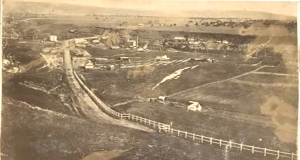
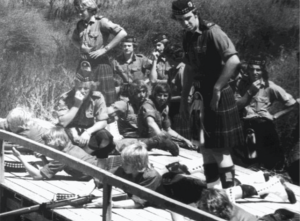
Hyland St and Fyansford in the 1850s (left) and Geelong College’s shooting range ca 1975.
An old Geelong College shooting range against the hill, near the base of its Preparatory School, is long gone. Photos from the day show prone students, capped, kilted and spatted, taking aim from a wooden platform.
The cliff-face below the top of the Deviation is today criss-crossed with tracks used by daredevil kids on their bikes. Old images show a dirt track lower than the present-day road. Vehicles could still get down to the river from a turn-off on the Deviation just above the confluence of the Barwon and Moorabool until the late 1990s. I recall finding a dumped car there among the boxthorns one time.
In the middle distance of these images can be seen the rocky redoubt of the Buckley’s Falls precinct. In the von Guerard picture, it’s well before the old paper mill and considerable vegetation now occupying the area. The golf course is still a paddock and a long way away into the future yet, the ring road too.
Further in the distance are the steep hills of Ceres, its viticulture and Swiss vignerons yet to be devastated by the phylloxera virus. Those same slopes are still there, of course, even if a good amount of housing is moving steadily toward them – might have to drive about four klicks to find the bush before long.
This article appeared in the Geelong Advertiser 17 July 2023


